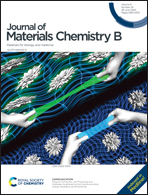Quantification of silk protein using phage nanofibers with high binding specificity†
Abstract
Silk sericin (SS) has emerged as an important silk protein for use in medicine and textiles. However, no sensitive method is available for detecting it. Here, we employed phage nanofibers (∼7 nm wide) as a probe to quantify SS from a dilute aqueous solution by exploiting two properties of the bacteria-infecting phage nanofibers, its use as a platform for discovering SS-binding peptide and its ultrasensitive quantification by a simple titering assay (where the number of phage nanofibers displaying the SS-binding peptide is equal to the number of countable millimeter-sized plaques derived from the phage nanofibers by infecting bacteria through plating). We first discovered a SS-binding peptide and the phage nanofibers (SS-phage) displaying this peptide at the tip. We found that this peptide can even differentiate SS from another silk protein (silk fibroin), showing its high specificity. We then employed SS-phage nanofibers as a probe to bind the SS casted from the aqueous solution. Because SS-phage nanofibers bound to the SS and the SS in the original SS solution were numerically correlated and the number of SS-phage nanofibers can be determined by counting the plaques in a Petri dish by the titering assay, determining the number of phage-derived plaques with the naked eye led to the rapid quantification of SS concentration with a detection limit of 19.50 ng ml−1. This phage-based counting strategy can be potentially applied to the facile detection of other proteins.



 Please wait while we load your content...
Please wait while we load your content...